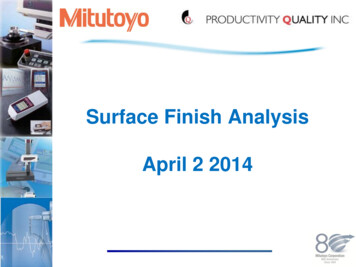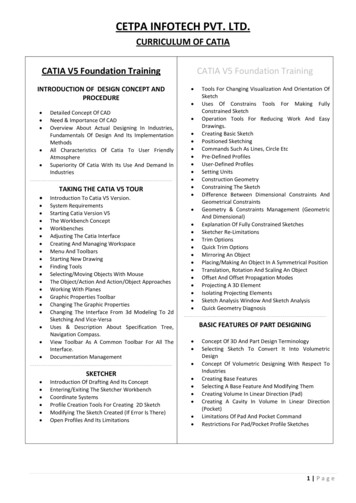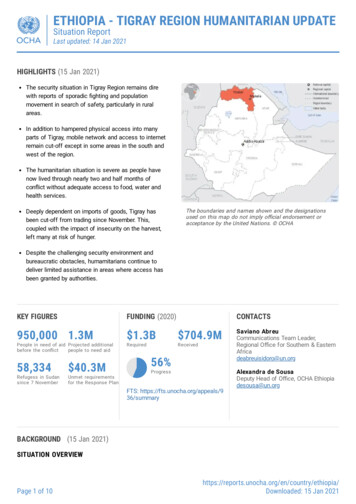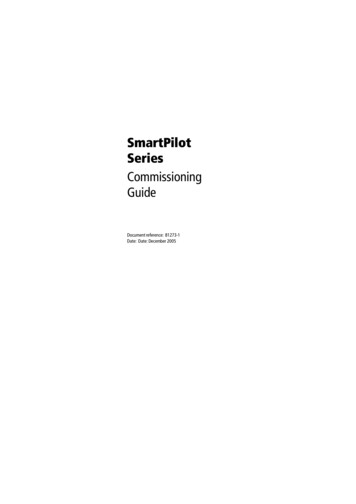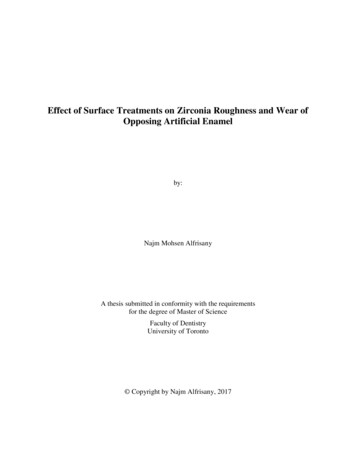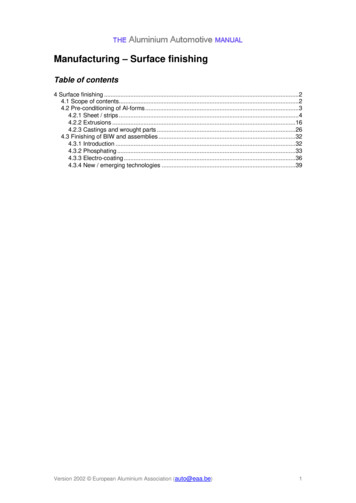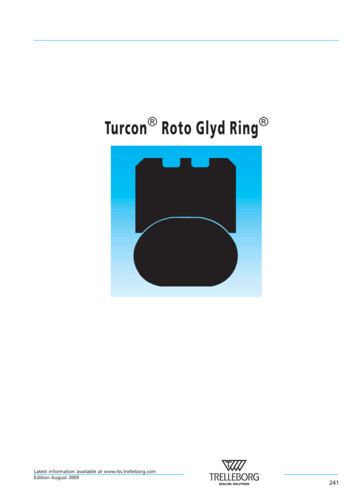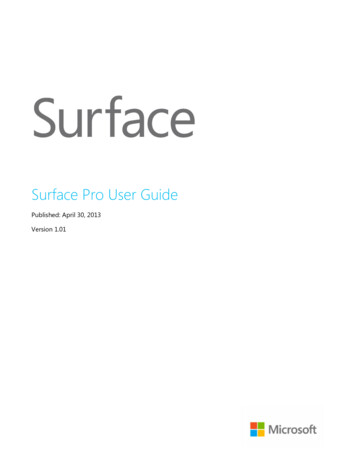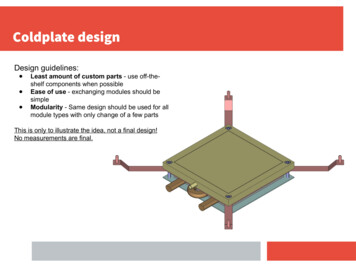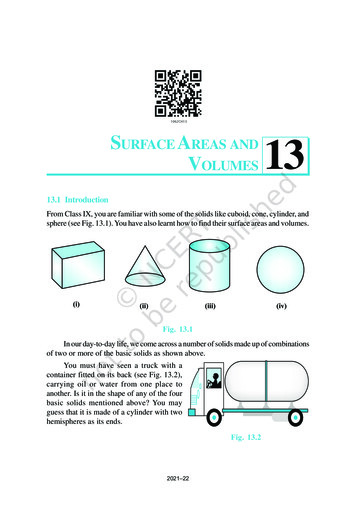
Transcription
SURFACE AREAS AND VOLUMES239SURFACE AREAS ANDVOLUMES1313.1 IntroductionFrom Class IX, you are familiar with some of the solids like cuboid, cone, cylinder, andsphere (see Fig. 13.1). You have also learnt how to find their surface areas and volumes.Fig. 13.1In our day-to-day life, we come across a number of solids made up of combinationsof two or more of the basic solids as shown above.You must have seen a truck with acontainer fitted on its back (see Fig. 13.2),carrying oil or water from one place toanother. Is it in the shape of any of the fourbasic solids mentioned above? You mayguess that it is made of a cylinder with twohemispheres as its ends.Fig. 13.22021–22
240MATHEMATICSAgain, you may have seen an object like theone in Fig. 13.3. Can you name it? A test tube, right!You would have used one in your science laboratory.This tube is also a combination of a cylinder and ahemisphere. Similarly, while travelling, you may haveseen some big and beautiful buildings or monumentsmade up of a combination of solids mentioned above.If for some reason you wanted to find thesurface areas, or volumes, or capacities of suchobjects, how would you do it? We cannot classifythese under any of the solids you have already studied.Fig. 13.3In this chapter, you will see how to find surface areas and volumes of suchobjects.13.2 Surface Area of a Combination of SolidsLet us consider the container seen in Fig. 13.2. How do we find the surface area ofsuch a solid? Now, whenever we come across a new problem, we first try to see, ifwe can break it down into smaller problems, we have earlier solved. We can see thatthis solid is made up of a cylinder with two hemispheres stuck at either end. It wouldlook like what we have in Fig. 13.4, after we put the pieces all together.Fig. 13.4If we consider the surface of the newly formed object, we would be able to seeonly the curved surfaces of the two hemispheres and the curved surface of the cylinder.So, the total surface area of the new solid is the sum of the curved surfaceareas of each of the individual parts. This gives,TSA of new solid CSA of one hemisphere CSA of cylinder CSA of other hemispherewhere TSA, CSA stand for ‘Total Surface Area’ and ‘Curved Surface Area’respectively.Let us now consider another situation. Suppose we are making a toy by puttingtogether a hemisphere and a cone. Let us see the steps that we would be goingthrough.2021–22
SURFACE AREAS AND VOLUMES241First, we would take a cone and a hemisphere and bring their flat faces together.Here, of course, we would take the base radius of the cone equal to the radius of thehemisphere, for the toy is to have a smooth surface. So, the steps would be as shownin Fig. 13.5.Fig. 13.5At the end of our trial, we have got ourselves a nice round-bottomed toy. Now ifwe want to find how much paint we would require to colour the surface of this toy,what would we need to know? We would need to know the surface area of the toy,which consists of the CSA of the hemisphere and the CSA of the cone.So, we can say:Total surface area of the toy CSA of hemisphere CSA of coneNow, let us consider some examples.Example 1 : Rasheed got a playing top (lattu) as hisbirthday present, which surprisingly had no colour onit. He wanted to colour it with his crayons. The top isshaped like a cone surmounted by a hemisphere(see Fig 13.6). The entire top is 5 cm in height andthe diameter of the top is 3.5 cm. Find the area hehas to colour. (Take π 22)7Fig. 13.6Solution : This top is exactly like the object we have discussed in Fig. 13.5. So, wecan conveniently use the result we have arrived at there. That is :TSA of the toy CSA of hemisphere CSA of coneNow, the curved surface area of the hemisphere 1(4πr 2 ) 2πr 2222 3.5 3.5 2 2 cm722 2021–22
.242MATHEMATICSAlso, the height of the cone height of the top – height (radius) of the hemispherical part3.5 5 cm 3.25 cm2 2 3.5 222So, the slant height of the cone (l ) r h (3.25) cm 3.7 cm (approx.)2 22 3.5 3.7 cm 2Therefore, CSA of cone πrl 72 This gives the surface area of the top as22 3.5 3.5 22 3.5 2 3.7 cm 2 2 cm 72272 22 3.511 ( 3.5 3.7 ) cm 2 (3.5 3.7) cm 2 39.6 cm2 (approx.)722You may note that ‘total surface area of the top’ is not the sum of the totalsurface areas of the cone and hemisphere. Example 2 : The decorative block shownin Fig. 13.7 is made of two solids — a cubeand a hemisphere. The base of the block is acube with edge 5 cm, and the hemispherefixed on the top has a diameter of 4.2 cm.Find the total surface area of the block.22(Take π )7Fig. 13.7Solution : The total surface area of the cube 6 (edge)2 6 5 5 cm2 150 cm2.Note that the part of the cube where the hemisphere is attached is not included in thesurface area.So,the surface area of the block TSA of cube – base area of hemisphere CSA of hemisphere 150 – πr2 2 πr2 (150 πr2) cm2 22 4.2 4.2 cm 2 150 cm2 22 7 (150 13.86) cm2 163.86 cm22021–22
SURFACE AREAS AND VOLUMES243Example 3 : A wooden toy rocket is in theshape of a cone mounted on a cylinder, asshown in Fig. 13.8. The height of the entirerocket is 26 cm, while the height of the conicalpart is 6 cm. The base of the conical portionhas a diameter of 5 cm, while the basediameter of the cylindrical portion is 3 cm. Ifthe conical portion is to be painted orangeand the cylindrical portion yellow, find thearea of the rocket painted with each of thesecolours. (Take π 3.14)Solution : Denote radius of cone by r, slantheight of cone by l, height of cone by h, radiusof cylinder by r′ and height of cylinder by h′.Then r 2.5 cm, h 6 cm, r′ 1.5 cm,h′ 26 – 6 20 cm andl r 2 h2 Fig. 13.82.52 62 cm 6.5 cmHere, the conical portion has its circular base resting on the base of the cylinder, butthe base of the cone is larger than the base of the cylinder. So, a part of the base of thecone (a ring) is to be painted.So,the area to be painted orange CSA of the cone base area of the cone– base area of the cylinder πrl πr2 – π(r′)2 π[(2.5 6.5) (2.5)2 – (1.5)2] cm2 π[20.25] cm2 3.14 20.25 cm2 63.585 cm2Now,the area to be painted yellow CSA of the cylinder area of one base of the cylinder 2πr′h′ π(r′)2 πr′ (2h′ r′) (3.14 1.5) (2 20 1.5) cm2 4.71 41.5 cm2 195.465 cm22021–22
244MATHEMATICSExample 4 : Mayank made a bird-bath for his gardenin the shape of a cylinder with a hemisphericaldepression at one end (see Fig. 13.9). The height ofthe cylinder is 1.45 m and its radius is 30 cm. Find the22total surface area of the bird-bath. (Take π )7Solution : Let h be height of the cylinder, and r thecommon radius of the cylinder and hemisphere. Then,Fig. 13.9the total surface area of the bird-bath CSA of cylinder CSA of hemisphere 2πrh 2πr2 2π r (h r)22 30(145 30) cm 27 33000 cm2 3.3 m2 2 EXERCISE 13.122 71. 2 cubes each of volume 64 cm3 are joined end to end. Find the surface area of theresulting cuboid.Unless stated otherwise, take π 2. A vessel is in the form of a hollow hemisphere mounted by a hollow cylinder. Thediameter of the hemisphere is 14 cm and the total height of the vessel is 13 cm. Find theinner surface area of the vessel.3. A toy is in the form of a cone of radius 3.5 cm mounted on a hemisphere of same radius.The total height of the toy is 15.5 cm. Find the total surface area of the toy.4. A cubical block of side 7 cm is surmounted by a hemisphere. What is the greatestdiameter the hemisphere can have? Find the surface area of the solid.5. A hemispherical depression is cut out from one face of a cubical wooden block suchthat the diameter l of the hemisphere is equal to the edge of the cube. Determine thesurface area of the remaining solid.6. A medicine capsule is in the shape of acylinder with two hemispheres stuck to eachof its ends (see Fig. 13.10). The length ofthe entire capsule is 14 mm and the diameterof the capsule is 5 mm. Find its surface area.2021–22Fig. 13.10
SURFACE AREAS AND VOLUMES2457. A tent is in the shape of a cylinder surmounted by a conical top. If the height anddiameter of the cylindrical part are 2.1 m and 4 m respectively, and the slant height of thetop is 2.8 m, find the area of the canvas used for making the tent. Also, find the cost ofthe canvas of the tent at the rate of 500 per m2. (Note that the base of the tent will notbe covered with canvas.)8. From a solid cylinder whose height is 2.4 cm and diameter 1.4 cm, a conical cavity of thesame height and same diameter is hollowed out. Find the total surface area of theremaining solid to the nearest cm2.9. A wooden article was made by scoopingout a hemisphere from each end of a solidcylinder, as shown in Fig. 13.11. If theheight of the cylinder is 10 cm, and itsbase is of radius 3.5 cm, find the totalsurface area of the article.13.3 Volume of a Combination of SolidsFig. 13.11In the previous section, we have discussed how to find the surface area of solids madeup of a combination of two basic solids. Here, we shall see how to calculate theirvolumes. It may be noted that in calculating the surface area, we have not added thesurface areas of the two constituents, because some part of the surface area disappearedin the process of joining them. However, this will not be the case when we calculatethe volume. The volume of the solid formed by joining two basic solids will actually bethe sum of the volumes of the constituents, as we see in the examples below.Example 5 : Shanta runs an industry ina shed which is in the shape of a cuboidsurmounted by a half cylinder (see Fig.13.12). If the base of the shed is ofdimension 7 m 15 m, and the height ofthe cuboidal portion is 8 m, find the volumeof air that the shed can hold. Further,suppose the machinery in the shedoccupies a total space of 300 m3, andthere are 20 workers, each of whomoccupy about 0.08 m 3 space on anaverage. Then, how much air is in the22shed? (Take π )72021–22Fig. 13.12
246MATHEMATICSSolution : The volume of air inside the shed (when there are no people or machinery)is given by the volume of air inside the cuboid and inside the half cylinder, takentogether.Now, the length, breadth and height of the cuboid are 15 m, 7 m and 8 m, respectively.Also, the diameter of the half cylinder is 7 m and its height is 15 m.So, the required volume volume of the cuboid 1volume of the cylinder21 22 7 7 15 m3 1128.75 m3 15 7 8 2 7 2 2 Next, the total space occupied by the machinery 300 m3And the total space occupied by the workers 20 0.08 m3 1.6 m3Therefore, the volume of the air, when there are machinery and workers 1128.75 – (300.00 1.60) 827.15 m3Example 6 : A juice seller was serving hiscustomers using glasses as shown in Fig. 13.13.The inner diameter of the cylindrical glass was5 cm, but the bottom of the glass had ahemispherical raised portion which reduced thecapacity of the glass. If the height of a glasswas 10 cm, find the apparent capacity of theglass and its actual capacity. (Use π 3.14.)Fig. 13.13Solution : Since the inner diameter of the glass 5 cm and height 10 cm,the apparent capacity of the glass πr 2 h 3.14 2.5 2.5 10 cm3 196.25 cm3But the actual capacity of the glass is less by the volume of the hemisphere at thebase of the glass.i.e.,it is less by2 3 23πr 3.14 2.5 2.5 2.5 cm 32.71 cm333So, the actual capacity of the glass apparent capacity of glass – volume of thehemisphere (196.25 – 32.71) cm3 163.54 cm32021–22
SURFACE AREAS AND VOLUMES247Example 7 : A solid toy is in the form of ahemisphere surmounted by a right circular cone. Theheight of the cone is 2 cm and the diameter of thebase is 4 cm. Determine the volume of the toy. If aright circular cylinder circumscribes the toy, find thedifference of the volumes of the cylinder and the toy.(Take π 3.14)Fig. 13.14Solution : Let BPC be the hemisphere and ABC be the cone standing on the baseof the hemisphere (see Fig. 13.14). The radius BO of the hemisphere (as well as1of the cone) 4 cm 2 cm.22 3 1 2So, volume of the toy πr πr h331 2 3.14 (2)3 3.14 (2) 2 2 cm3 25.12 cm33 3 Now, let the right circular cylinder EFGH circumscribe the given solid. The radius ofthe base of the right circular cylinder HP BO 2 cm, and its height isEH AO OP (2 2) cm 4 cmSo, the volume required volume of the right circular cylinder – volume of the toy (3.14 22 4 – 25.12) cm3 25.12 cm3Hence, the required difference of the two volumes 25.12 cm3.EXERCISE 13.222.71 . A solid is in the shape of a cone standing on a hemisphere with both their radii beingequal to 1 cm and the height of the cone is equal to its radius. Find the volume of the solidin terms of π.Unless stated otherwise, take π 2. Rachel, an engineering student, was asked to make a model shaped like a cylinder withtwo cones attached at its two ends by using a thin aluminium sheet. The diameter of themodel is 3 cm and its length is 12 cm. If each cone has a height of 2 cm, find the volumeof air contained in the model that Rachel made. (Assume the outer and inner dimensionsof the model to be nearly the same.)2021–22
248MATHEMATICS3. A gulab jamun, contains sugar syrup up to about30% of its volume. Find approximately how muchsyrup would be found in 45 gulab jamuns, eachshaped like a cylinder with two hemispherical endswith length 5 cm and diameter 2.8 cm (see Fig. 13.15).Fig. 13.154. A pen stand made of wood is in the shape of acuboid with four conical depressions to hold pens.The dimensions of the cuboid are 15 cm by 10 cm by3.5 cm. The radius of each of the depressions is 0.5cm and the depth is 1.4 cm. Find the volume ofwood in the entire stand (see Fig. 13.16).5. A vessel is in the form of an inverted cone. Itsheight is 8 cm and the radius of its top, which isopen, is 5 cm. It is filled with water up to the brim.When lead shots, each of which is a sphere of radius0.5 cm are dropped into the vessel, one-fourth ofthe water flows out. Find the number of lead shotsdropped in the vessel.Fig. 13.166. A solid iron pole consists of a cylinder of height 220 cm and base diameter 24 cm, whichis surmounted by another cylinder of height 60 cm and radius 8 cm. Find the mass of thepole, given that 1 cm3 of iron has approximately 8g mass. (Use π 3.14)7. A solid consisting of a right circular cone of height 120 cm and radius 60 cm standing ona hemisphere of radius 60 cm is placed upright in a right circular cylinder full of watersuch that it touches the bottom. Find the volume of water left in the cylinder, if the radiusof the cylinder is 60 cm and its height is 180 cm.8. A spherical glass vessel has a cylindrical neck 8 cm long, 2 cm in diameter; the diameterof the spherical part is 8.5 cm. By measuring the amount of water it holds, a child finds itsvolume to be 345 cm3. Check whether she is correct, taking the above as the insidemeasurements, and π 3.14.13.4 Conversion of Solid from One Shape to AnotherWe are sure you would have seen candles.Generally, they are in the shape of a cylinder.You may have also seen some candlesshaped like an animal (see Fig. 13.17).Fig. 13.172021–22
SURFACE AREAS AND VOLUMES249How are they made? If you want a candle of any special shape, you will have toheat the wax in a metal container till it becomes completely liquid. Then you will have topour it into another container which has the special shape that you want. For example,take a candle in the shape of a solid cylinder, melt it and pour whole of the molten waxinto another container shaped like a rabbit. On cooling, you will obtain a candle in theshape of the rabbit. The volume of the new candle will be the same as the volume ofthe earlier candle. This is what wehave to remember when we comeacross objects which are convertedfrom one shape to another, or whena liquid which originally filled onecontainer of a particular shape ispoured into another container of adifferent shape or size, as you see inFig. 13.18Fig 13.18.To understand what has been discussed, let us consider some examples.Example 8: A cone of height 24 cm and radius of base 6 cm is made up of modellingclay. A child reshapes it in the form of a sphere. Find the radius of the sphere.1 π 6 6 24 cm334 3If r is the radius of the sphere, then its volume is π r .3Since, the volume of clay in the form of the cone and the sphere remains the same, wehave41 π r 3 π 6 6 2433i.e.,r3 3 3 24 33 23Solution : Volume of cone So,r 3 2 6Therefore, the radius of the sphere is 6 cm.Example 9 : Selvi’s house has an overhead tank in the shape of a cylinder. Thisis filled by pumping water from a sump (an underground tank) which is in theshape of a cuboid. The sump has dimensions 1.57 m 1.44 m 95cm. Theoverhead tank has its radius 60 cm and height 95 cm. Find the height of the waterleft in the sump after the overhead tank has been completely filled with waterfrom the sump which had been full. Compare the capacity of the tank with that ofthe sump. (Use π 3.14)2021–22
250MATHEMATICSSolution : The volume of water in the overhead tank equals the volume of the waterremoved from the sump.Now, the volume of water in the overhead tank (cylinder) πr2h 3.14 0.6 0.6 0.95 m3The volume of water in the sump when full l b h 1.57 1.44 0.95 m3The volume of water left in the sump after filling the tank [(1.57 1.44 0.95) – (3.14 0.6 0.6 0.95)] m3 (1.57 0.6 0.6 0.95 2) m3volume of water left in the sumpl bSo, the height of the water left in the sump 1.57 0.6 0.6 0.95 2m1.57 1.44 0.475 m 47.5 cmAlso,Capacity of tank3.14 0.6 0.6 0.95 1 Capacity of sump1.57 1.44 0.952Therefore, the capacity of the tank is half the capacity of the sump.Example 10 : A copper rod of diameter 1 cm and length 8 cm is drawn into a wire oflength 18 m of uniform thickness. Find the thickness of the wire.2 1 Solution : The volume of the rod π 8 cm3 2 π cm3 . 2 The length of the new wire of the same volume 18 m 1800 cmIf r is the radius (in cm) of cross-section of the wire, its volume π r2 1800 cm3π r2 1800 2π1i.e.,r2 9001i.e.,r 301So, the diameter of the cross section, i.e., the thickness of the wire iscm,15i.e., 0.67mm (approx.).4Example 11 : A hemispherical tank full of water is emptied by a pipe at the rate of 37litres per second. How much time will it take to empty half the tank, if it is 3m in22diameter? (Take π )7Therefore,2021–22
SURFACE AREAS AND VOLUMES251Solution : Radius of the hemispherical tank Volume of the tank So, the volume of the water to be emptied Since,in3m2399 32 22 3 m m3 143 7 2 1 99 3 99 m 1000 litres2 142899000litres289900025litres of water is emptied in 1 second,litres of water will be emptied28799000 7 seconds, i.e., in 16.5 minutes.2825EXERCISE 13.3Take π 22, unless stated otherwise.71. A metallic sphere of radius 4.2 cm is melted and recast into the shape of a cylinder ofradius 6 cm. Find the height of the cylinder.2. Metallic spheres of radii 6 cm, 8 cm and 10 cm, respectively, are melted to form a singlesolid sphere. Find the radius of the resulting sphere.3. A 20 m deep well with diameter 7 m is dug and the earth from digging is evenly spread outto form a platform 22 m by 14 m. Find the height of the platform.4. A well of diameter 3 m is dug 14 m deep. The earth taken out of it has been spread evenlyall around it in the shape of a circular ring of width 4 m to form an embankment. Find theheight of the embankment.5. A container shaped like a right circular cylinder having diameter 12 cm and height 15 cmis full of ice cream. The ice cream is to be filled into cones of height 12 cm and diameter6 cm, having a hemispherical shape on the top. Find the number of such cones which canbe filled with ice cream.6. How many silver coins, 1.75 cm in diameter and of thickness 2 mm, must be melted to forma cuboid of dimensions 5.5 cm 10 cm 3.5 cm?2021–22
252MATHEMATICS7. A cylindrical bucket, 32 cm high and with radius of base 18 cm, is filled with sand. Thisbucket is emptied on the ground and a conical heap of sand is formed. If the height of theconical heap is 24 cm, find the radius and slant height of the heap.8. Water in a canal, 6 m wide and 1.5 m deep, is flowing with a speed of 10 km/h. How mucharea will it irrigate in 30 minutes, if 8 cm of standing water is needed?9. A farmer connects a pipe of internal diameter 20 cm from a canal into a cylindrical tank inher field, which is 10 m in diameter and 2 m deep. If water flows through the pipe at therate of 3 km/h, in how much time will the tank be filled?13.5 Frustum of a ConeIn Section 13.2, we observed objects that are formed when two basic solids werejoined together. Let us now do something different. We will take a right circular coneand remove a portion of it. There are so many waysin which we can do this. But one particular case thatwe are interested in is the removal of a smaller rightcircular cone by cutting the given cone by a planeparallel to its base. You must have observed that theglasses (tumblers), in general, used for drinking water,are of this shape. (See Fig. 13.19)Fig. 13.19Activity 1 : Take some clay, or any other such material (like plasticine, etc.) and forma cone. Cut it with a knife parallel to its base. Remove the smaller cone. What are youleft with?You are left with a solid called a frustum of the cone. You can see that thishas two circular ends with different radii.So, given a cone, when we slice (or cut) through it with a plane parallel to its base(see Fig. 13.20) and remove the cone that is formed on one side of that plane, the partthat is now left over on the other side of the plane is called a frustum* of the cone.Fig. 13.20*‘Frustum’ is a latin word meaning ‘piece cut off’, and its plural is ‘frusta’.2021–22
SURFACE AREAS AND VOLUMES253How can we find the surface area and volume of a frustum of a cone? Letus explain it through an example.Example 12 : The radii of the ends of a frustumof a cone 45 cm high are 28 cm and 7 cm(see Fig. 13.21). Find its volume, the curvedsurface area and the total suface area(Take π 22).7Solution : The frustum can be viewed as a difference of two right circular cones OAB andOCD (see Fig. 13.21). Let the height (in cm)of the cone OAB be h1 and its slant height l1,i.e., OP h1 and OA OB l1. Let h2 be theheight of cone OCD and l2 its slant height.Fig. 13.21We have : r1 28 cm, r2 7 cmand the height of frustum (h) 45 cm. Also,h1 45 h2(1)We first need to determine the respective heights h1 and h2 of the cone OABand OCD.Since the triangles OPB and OQD are similar (Why?), we have4h1 28 1h27(2)From (1) and (2), we get h2 15 and h1 60.Now, the volume of the frustum volume of the cone OAB – volume of the cone OCD1 22 1 22 (28) 2 (60) (7) 2 (15) cm3 48510 cm3 3 7 3 7 The respective slant height l2 and l1 of the cones OCD and OAB are givenbyl2 (7)2 (15) 2 16.55 cm (approx.)l1 (28) 2 (60) 2 4 (7) 2 (15) 2 4 16.55 66.20 cm2021–22
254MATHEMATICSThus, the curved surface area of the frustum πr1l1 – πr2l22222(28)(66.20) –(7)(16.55) 5461.5 cm277Now, the total surface area of the frustum the curved surface area πr12 πr222222 2 2(28) 2 cm 2 (7) cm77 5461.5 cm2 2464 cm2 154 cm2 8079.5 cm2. 5461.5 cm2 Let h be the height, l the slant height and r1 and r2 the radii of the ends(r1 r2) of the frustum of a cone. Then we can directly find the volume, thecurved surace area and the total surface area of frustum by using the formulaegiven below :1πh(r12 r22 r1r2 ) .3(ii) the curved surface area of the frustum of the cone π(r1 r2)l(i) Volume of the frustum of the cone where l h2 (r1 r2 ) 2 .(iii) Total surface area of the frustum of the cone πl (r1 r2) πr12 πr22,where l h2 (r1 r2 ) 2 .These formulae can be derived using the idea of similarity of triangles but weshall not be doing derivations here.Let us solve Example 12, using these formulae :(i) Volume of the frustum 1π h r12 r22 r1r23()1 22 45 (28) 2 (7) 2 (28)(7) cm33 7 48510 cm3(ii) We havel 2h 2 ( r1 r2 ) (45) 2 (28 7) 2 cm 3 (15) 2 (7) 2 49.65 cm2021–22
SURFACE AREAS AND VOLUMES255So, the curved surface area of the frustum π(r1 r2) l 22(28 7) (49.65) 5461.5 cm27(iii) Total surface area of the frustum22 π ( r1 r2 ) l πr1 πr2 5461.5 2222 2 (28)2 (7) cm2 8079.5 cm277 Let us apply these formulae in some examples.Example 13 : Hanumappa and his wife Gangamma arebusy making jaggery out of sugarcane juice. They haveprocessed the sugarcane juice to make the molasses,which is poured into moulds in the shape of a frustum ofa cone having the diameters of its two circular faces as30 cm and 35 cm and the vertical height of the mould is14 cm (see Fig. 13.22). If each cm3 of molasses hasmass about 1.2 g, find the mass of the molasses that canFig. 13.2222 be poured into each mould. Take π 7 Solution : Since the mould is in the shape of a frustum of a cone, the quantity (volume)of molasses that can be poured into it πh ( r12 r22 r1 r2 ) ,3where r1 is the radius of the larger base and r2 is the radius of the smaller base. 35 2 30 2 35 30 31 22 3 7 14 2 2 2 2 cm 11641.7 cm3. It is given that 1 cm3 of molasses has mass 1.2g. So, the mass of the molasses that canbe poured into each mould (11641.7 1.2) g 13970.04 g 13.97 kg 14 kg (approx.)2021–22
256MATHEMATICSExample 14 : An open metal bucket is in theshape of a frustum of a cone, mounted on ahollow cylindrical base made of the same metallic sheet (see Fig. 13.23). The diameters ofthe two circular ends of the bucket are 45 cmand 25 cm, the total vertical height of the bucketis 40 cm and that of the cylindrical base is6 cm. Find the area of the metallic sheet usedto make the bucket, where we do not take intoaccount the handle of the bucket. Also, findthe volume of water the bucket can hold.Fig. 13.2322.7Solution : The total height of the bucket 40 cm, which includes the height of thebase. So, the height of the frustum of the cone (40 – 6) cm 34 cm.Take π Therefore, the slant height of the frustum, l h2 (r1 r2 ) 2 ,where r1 22.5 cm, r2 12.5 cm and h 34 cm.So,l 342 (22.5 12.5) 2 cm342 102 35.44 cmThe area of metallic sheet used curved surface area of frustum of cone area of circular base curved surface area of cylinder [π 35.44 (22.5 12.5) π (12.5)2 2π 12.5 6] cm2 22(1240.4 156.25 150) cm27 4860.9 cm22021–22
SURFACE AREAS AND VOLUMES257Now, the volume of water that the bucket can hold (also, known as the capacityof the bucket) π h ( r12 r22 r1r2 )3 22 34 [(22.5) 2 (12.5) 2 22.5 12.5] cm373 22 34 943.75 33615.48 cm373 33.62 litres (approx.)EXERCISE 13.4Use π 22unless stated otherwise.71. A drinking glass is in the shape of a frustum of acone of height 14 cm. The diameters of its twocircular ends are 4 cm and 2 cm. Find the capacity ofthe glass.2. The slant height of a frustum of a cone is 4 cm andthe perimeters (circumference) of its circular endsare 18 cm and 6 cm. Find the curved surface area ofthe frustum.3. A fez, the cap used by the Turks, is shaped like thefrustum of a cone (see Fig. 13.24). If its radius on theopen side is 10 cm, radius at the upper base is 4 cmand its slant height is 15 cm, find the area of materialused for making it.Fig. 13.244. A container, opened from the top and made up of a metal sheet, is in the form of afrustum of a cone of height 16 cm with radii of its lower and upper ends as 8 cm and 20cm, respectively. Find the cost of the milk which can completely fill the container, at therate of 20 per litre. Also find the cost of metal sheet used to make the container, if itcosts 8 per 100 cm2. (Take π 3.14)5. A metallic right circular cone 20 cm high and whose vertical angle is 60 is cut into twoparts at the middle of its height by a plane parallel to its base. If the frustum so obtained1be drawn into a wire of diametercm, find the length of the wire.162021–22
258MATHEMATICSEXERCISE 13.5 (Optional)*1. A copper wire, 3 mm in diameter, is wound about a cylinder whose length is 12 cm, anddiameter 10 cm, so as to cover the curved surface of the cylinder. Find the length andmass of the wire, assuming the density of copper to be 8.88 g per cm3.2. A right triangle, whose sides are 3 cm and 4 cm (other than hypotenuse) is made torevolve about its hypotenuse. Find the volume and surface area of the double cone soformed. (Choose value of π as found appropriate.)3. A cistern, internally measuring 150 cm 120 cm 110 cm, has 129600 cm3 of water in it.Porous bricks are placed in the water until the cistern is full to the brim. Each brickabsorbs one-seventeenth of its own volume of water. How many bricks can be put inwithout overflowing the water, each brick being 22.5 cm 7.5 cm 6.5 cm?4. In one fortnight of a given month, there was a rainfall of 10 cm in a river valley. If the areaof the valley is 7280 km2, show that the total rainfall was approximately equivalent tothe addition to the normal water of three rivers each 1072 km long, 75 m wide and 3 mdeep.5. An oil funnel made of tin sheet consists of a10 cm long cylindrical portion attached to afrustum of a cone. If the total height is 22 cm,diameter of the cylindrical portion is 8 cm andthe diameter of the top of the funnel is 18 cm,find the area of the tin sheet required to makethe funnel (see Fig. 13.25).Fig. 13.256. Derive the formula for the curved surface area and total surface area of the frustum of acone, given to you in Section 13.5, using the symbols as explained.7. Derive the formula for the volume of the frustum of a cone, given to you in Section 13.5,using the symbols as explained.13.6 SummaryIn this chapter, yo
Example 4 : Mayank made a bird-bath for his garden in the shape of a cylinder with a hemispherical depression at one end (see Fig. 13.9). The height of the cylinder is 1.45 m and its radius is 30 cm. Find the total surface area of the bird-bath. (Take π 22
